Labor shortages continue to harm the U.S. economy, adding to ongoing inflation, increasing the risks of an economic down, and exacerbating the federal government’s irrefutably unsustainable fiscal outlook. This Backgrounder examines the current U.S. labor market by diving deeper into the employment trends among different groups of workers with data through March 2023.REF Building on the first three Backgrounders in this employment-trends series, this update includes additional considerations of factors affecting ongoing labor shortages, such as the opioid pandemic, long COVID, the recent spike in home values, and various government welfare benefits.REF
Uncertainty Reigns, Labor Shortages Remain
Following an unprecedentedly strong labor market in 2022, workers and employers face growing uncertainty in 2023. After two quarters of negative economic growth in 2022 and expectations for meager growth in 2023, businesses and investors are questioning the strength of the economy and the Federal Reserve’s ability to maneuver a soft landing after a 34 percent ($8 trillion) increase in federal debt over the past three years, with the majority of that debt financed by the Federal Reserve creating new money that exacerbated inflation.REF
Compared to pre-pandemic employment rates, 2.0 million fewer people are working today.REF In addition to the decline in the number of workers, the average number of hours worked over the past two years has also declined. From March 2021 to March 2023, average hours worked declined from 34.9 to 34.4, which translates to 2.2 million fewer full-time-equivalent workers. A February 2022 economic analysis estimated that the decline in work hours roughly doubled the magnitude of the labor force decline, and average hours worked have declined since then.REF
The decline in employment remains despite unprecedented demand for workers. The current 9.9 million job openings (February 2023) is 2.4 million above the pre-pandemic record, and equals 1.7 available jobs for every unemployed person.REF According to the National Federation of Independent Business’s March 2023 jobs report, 43 percent of all small businesses reported job openings that they could not fill.REF Labor and inflation continue to dominate small business concerns, with 23 percent of owners citing labor quality as the single greatest concern, 11 percent citing labor costs, and 24 percent citing inflation.REF Consequently, a net 42 percent of small businesses reported raising compensation over the previous three months, and a net 22 percent reported planning to increase compensation over the following three months, while a net 37 percent of businesses reported increasing their prices over the previous three months.REF
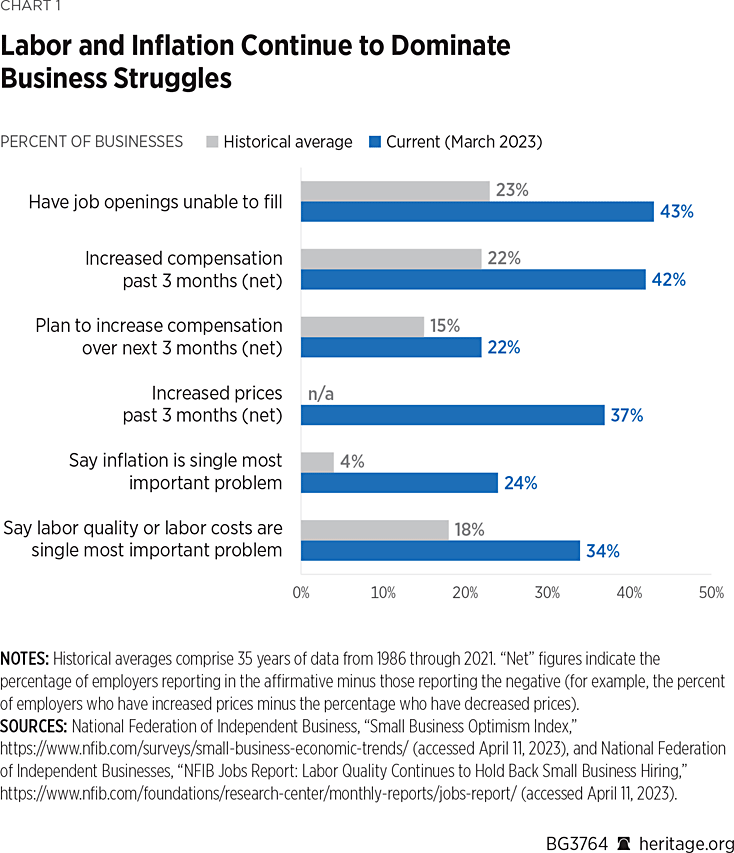
An exceptionally tight labor market is the opposite of what economists expected going into the COVID-19 pandemic, but the federal government’s outsized, protracted, and sometimes harmful responses contributed to the shortage of workers. An additional $7.5 trillion in new federal spending between 2020 and 2022REF—roughly half of which was financed by money created by the Federal Reserve—fueled demand for goods and services while super-sized unemployment insurance and other welfare-without-work benefits restricted the labor supply.
From March 2021 to March 2023, average hours worked declined from 34.9 to 34.4, which translates to 2.2 million fewer full-time-equivalent workers.
The government-induced shortage of workers has contributed to the inflationary cycle, reduced economic output, increased the risks of a recession, and exacerbated unsustainable federal deficits and debt.
Inflation. A Federal Reserve study found that the widely available weekly $600 unemployment insurance bonuses allowed two-thirds of workers to make more from unemployment than from working.REF Economic studies showed that these unemployment bonuses reduced the labor supply.REF
Although unemployment insurance bonuses are no longer being paid out, it appears that other additional welfare payment increases that were supposed to be temporary continue to weigh down the workforce. For example, the Administration’s action to increase Supplemental Nutrition Assistance Program (SNAP) benefits by 21 percent, an ongoing expansion of Obamacare subsidies, and nearly three years of student-loan-payment pauses have made it easier for many people to work less or not work at all. A December 2022 analysis by Heritage Foundation researcher E. J. Antoni and former chief economist at the White House Council of Economic Advisers Casey Mulligan found that unemployment benefits plus the expanded Affordable Care Act (ACA) subsidies for families of four with no worker can exceed the median household income in 24 states.REF
Fewer workers means that employers have to pay people more for the exact same output, which means that businesses must raise their prices. And when prices increase, workers demand even higher wages to maintain their purchasing power, which adds to the inflationary cycle. As the National Federation of Independent Business’s January 2023 Small Business Optimism Index reported, “While other input costs are falling labor costs are resisting.”REF The most recent report, from March 2023, found that a net 42 percent of businesses reported raising compensation over the previous three months and 22 percent plan to increase it over the coming three months.REF
Although average weekly earnings increased by an above-average 8.8 percent over the past two years (March 2021 to March 2023), real weekly earnings (taking into account the effect of inflation) were down by 6.2 percent.REF That means that, although a full-time median worker earned an extra $5,600 in total over the past two years, his purchasing power went down by $8,600, making him $3,000 poorer overall.REF
Reduced Output. The rate of real gross domestic product (GDP) growth declined in the first two quarters of 2022, even as demand for goods and services was strong. Too few workers almost certainly factored into that decline and continues to contribute to risks of the U.S. entering a recession within the next year.
A popular rule of thumb called Okun’s law (named after economist Arthur Okun) says that each one-percentage-point decrease in the unemployment rate roughly corresponds to a two-percentage-point increase in the growth rate of real GDP. While unemployment is exceptionally low today, the fact that worker shortages remain high suggests that the addition of millions of missing workers who stopped looking for work (and therefore were not counted as unemployed) could have a similar impact on output as prescribed by Okun’s law. For example, I applied Okun’s law to estimate that the addition of 3.2 million missing workers in the first half of 2022 would have shifted the pace of GDP growth from –1.6 percent and –0.9 percent in the first and second quarters of 2022 to 2.4 percent and 2.9 percent, respectively.REF
More workers in the labor force would have meant fewer people waiting for delayed health care, fewer canceled flights, fewer educational disruptions due to missing bus drivers and teachers, and less crime resulting from police shortages.
It is important to note what this lost opportunity represents in concrete terms. More workers in the labor force would have meant fewer people waiting in overcrowded emergency rooms and having their access to health care delayed, fewer canceled flights, fewer educational disruptions due to missing bus drivers and teachers, and fewer crimes resulting from police shortages. Moreover, the value to the sidelined workers who could and should have been working is enormous and potentially lifelong. Economic studies show that even short-term unemployment can lead to a decline in physical and mental well-beingREF and reduced fertility,REF and that long-term unemployment tends to lead to lower incomes and diminished career trajectories,REF lower incomes, and higher rates of disability insurance receipts.REF
Even Higher Deficits and Debt. Fewer people working is a double drain on government finances because it means lower tax revenues and higher government spending on welfare transfer payments. If federal transfer payments had remained at their 2010–2019 average of 14.9 percent of GDP, the federal government would have spent $2.5 trillion less in federal transfers between 2020 and 2022.REF And, if federal income and payroll tax revenues were increased by amounts proportional to the artificially induced gaps in employment that existed between 2020 and 2022, the federal government would have received an additional $466 billion in individual income and payroll taxes alone.REF Combined, the $2.5 trillion in increased transfers and $466 billion in lost revenues—nearly $3 trillion total—from lower employment amounts to an additional $22,800 in debt for every household in America.
Combined, the $2.5 trillion in increased transfers and $466 billion in reduced revenues—nearly $3 trillion total—from lower employment amounts to an additional $22,800 in debt for every household in America.
Increased deficits and debt from government-imposed lockdowns and accompanying government transfer payments were expected in the short term, but prolonged restrictions, excessive government welfare-without-work benefits, and massive spending packages passed under the guise of COVID-19 relief have exacerbated federal debt and deficits by trillions of dollars. Absent inflating its way out of that debt, the only way that the government can repay massive overspending will be to tax working Americans. Since raising taxes on something means that one gets less of it, higher taxes on labor would further weaken America’s workforce.
Who’s Not Working? Current Gaps Concentrated Among the Young, Those Over 65, Men, and the Childless
Throughout the pandemic, different groups of workers have been affected differently. For example, at the beginning of the pandemic, lower-wage workers and working women who were caregivers were more likely to have lost jobs or dropped out of the labor force. Also, older workers faced greater health concerns from COVID-19, which affected their employment. Once the economy started opening back up, teenagers disproportionately took advantage of increased job opportunities and higher wages. Since the start of the pandemic, demographic changes in employment have shifted.
This labor market series (of which this is the fourth edition) calculates an “employment gap,” which represents the difference between current employment levels for each specified group of individuals (based on the most recent March 2023 data) and what those levels would have been absent the pandemic, by assuming employment-to-population ratios had remained constant at their February 2020 levels. Three years after the start of the pandemic, the total employment gap is 2.0 million workers, or 1.3 percent below the employment rate of February 2020.
Broken down by age, sex, and presence of children, employment gaps are concentrated among young people, workers ages 65 and older, and childless individuals.
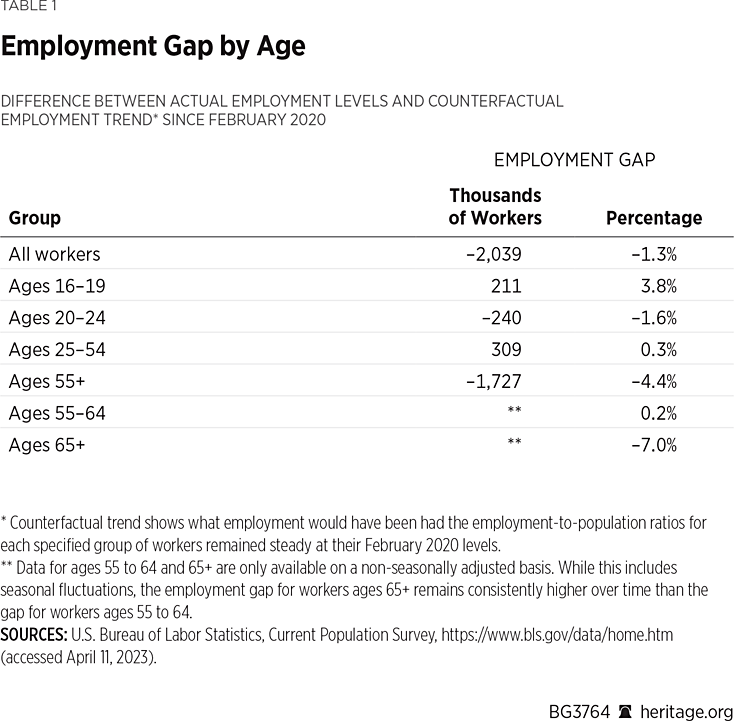
Large Decline in Employment Among Young, Early-Career Workers. Despite widespread availability of jobs across industries and skill levels, employers’ increasing willingness to train workers, and large increases in starting compensation, young workers have experienced the largest employment declines aside from workers ages 65 and older.REF Young workers between the ages of 20 and 24, who are traditionally just starting out their careers, have a troubling 1.6 percent employment gap, compared to a 0.3 percent employment surplus for workers ages 25 to 54.REF
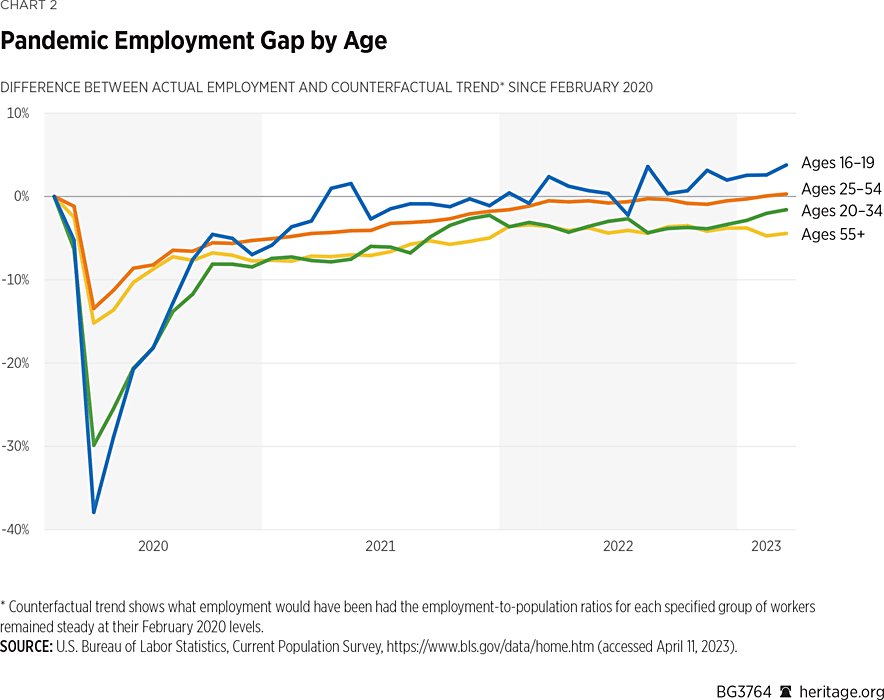
The decline in employment among individuals ages 20 to 24 cannot be explained by an increase in higher education attendance. Undergraduate employment in the fall of 2022 was down by 7.6 percent (1.2 million fewer students) compared to the fall of 2019, demonstrating an even more problematic rise in the number of young Americans who are neither working nor attending school.REF As education and work in the early years of adulthood are foundational for building careers and establishing effective work and lifestyle habits, this increase in apparent idleness or potentially harmful behaviors does not bode well for young Americans and the future workforce.
Reversing this decline in employment among workers who are just starting out their careers must include reducing work disincentives and expanding alternative education opportunities. (See the final section, “Policies to Promote Employment, Educated Workers, Higher Incomes, and General Well-Being.)
Ages 65+ Employment Decline. At the other end of the age spectrum, older workers’ employment declined sharply at the onset of the pandemic and has not fully recovered. The topline seasonally adjusted data shows a 4.4 percent employment gap for workers ages 55 and older. However, a further breakdown of age groups indicates that the employment gap is entirely among workers ages 65 and older. Workers ages 55 to 64 have experienced a 0.2 percent employment surplus, while workers ages 65 and older have a 7.0 percent gap. (Data for age breakdowns are only available on a non–seasonally adjusted basis, but they reveal consistent patterns of employment declines concentrated in workers over age 65.)
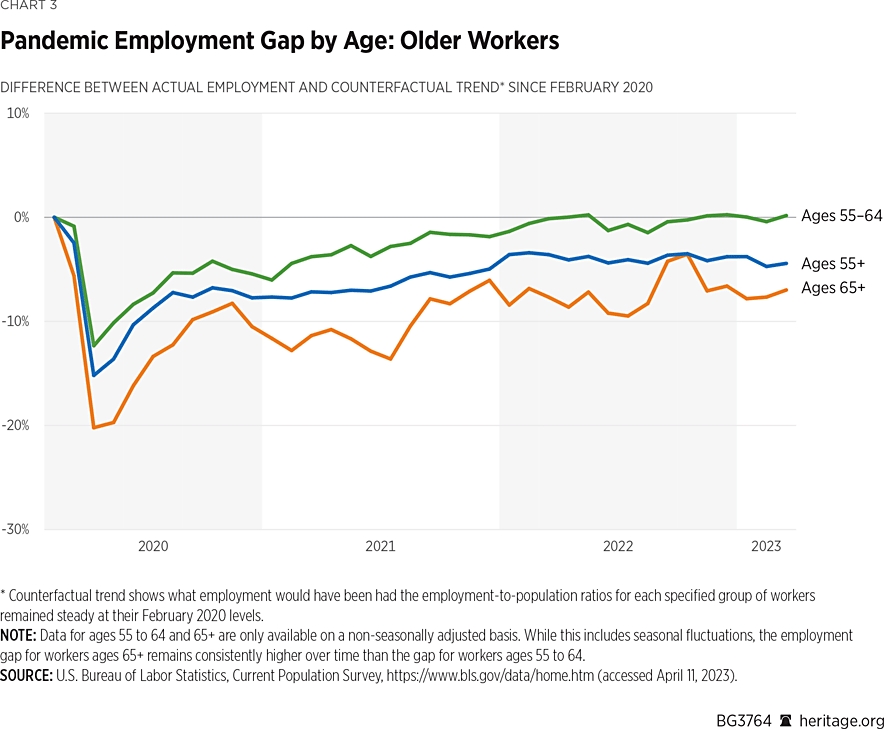
Early in the pandemic, the decline in older Americans’ work was not surprising, considering their increased risks from COVID-19. Lasting declines could be partly explained by older Americans’ early retirements, though the increase in remote and flexible work opportunities has made it easier for many people—particularly the most tenured workers—to work in ways that work best for them. As discussed below under “Rapid Home-Price Growth,” the spike in home price values appears to have significantly reduced older Americans’ employment.
Male v. Female Employment Gaps. Men’s employment is down 1.4 percent since February 2020, while women’s is down 1.3 percent. Looking just at workers in the 25-to-54 prime-age range, men’s prime-age employment is down 0.3 percent while prime-age women’s employment is up by 0.5 percent. This marks a significant change from the beginning of the pandemic when women were more likely to have lost jobs and to have stopped working to care for children. More flexible workplace policies, such as remote work options, alternative schedules, and new and expanded paid family leave benefits have almost certainly contributed to women’s relative employment gains. As discussed below under “Parents vs. Childless Workers,” while childcare continues to disproportionately affect women, pandemic-related shifts in the ways people work and live may have eased childcare struggles.
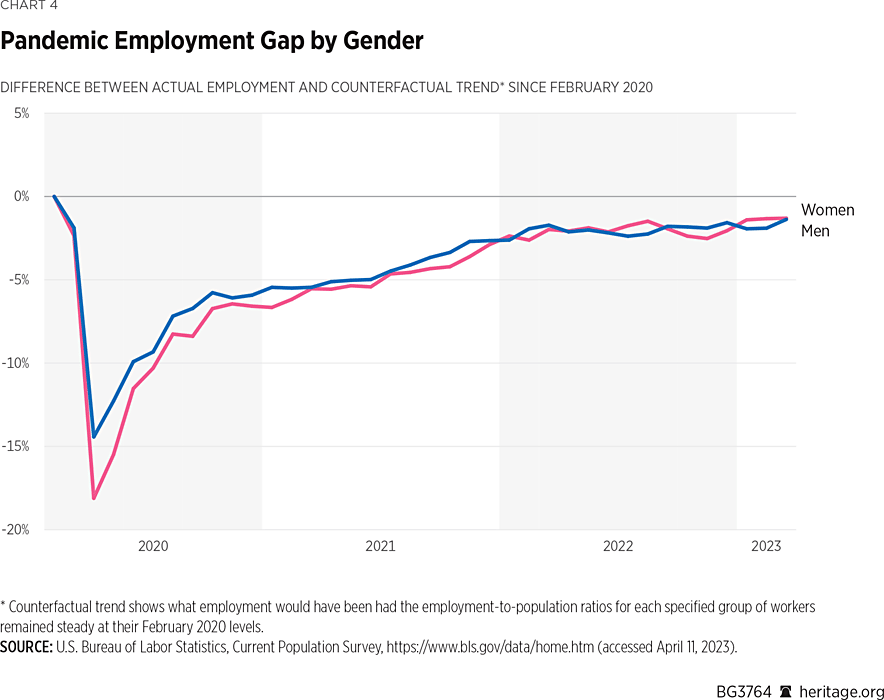
Large Shifts in Employment Trends for Mothers, Fathers, and Childless Workers. Early in the pandemic, school and childcare closures significantly disrupted parents’—predominantly mothers’—ability to work. Moreover, pandemic-related concerns and restrictions in nursing homes and hospitals meant that more workers, predominantly women, were having to spend time caring for older family members. Yet, the data reveal that while these were significant concerns and struggles, they did not disproportionately affect women’s and parents’ employment.
Table 2 provides a breakdown of the employment gaps for various groups of workers based on sex, and presence and age of children, as measured by the percentage difference between current employment (March 2023) and where it would have been absent the pandemic, by assuming employment-to-population ratios had remained constant.REF
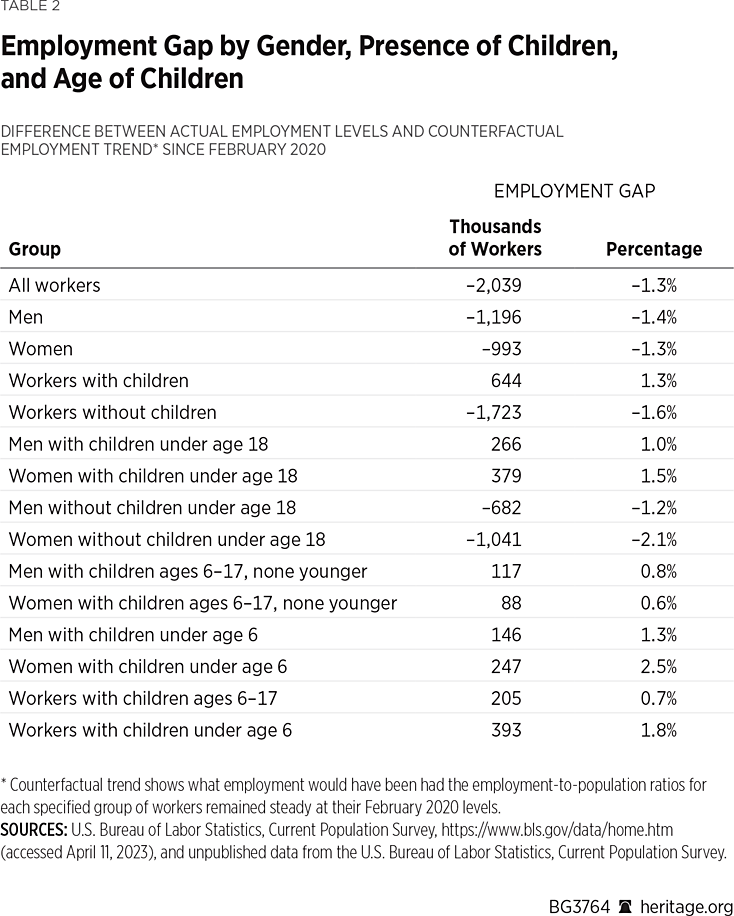
Parents vs. Childless Workers. Throughout the pandemic, parents with children under age 18 at home have experienced smaller employment gaps than childless workers (who either have no children or have no children under age 18 living at home).REF Despite the narrative that parents’ employment was disproportionately harmed by school and childcare closures, the data do not reveal that to have been the case, as parents have consistently experienced smaller employment gaps than those without children. Currently, workers without children have a 1.6 percent employment gap, while workers with children have an employment surplus of 1.0 percent compared to what their employment levels would have been had each group’s February 2020 employment-to-population ratio remained constant.
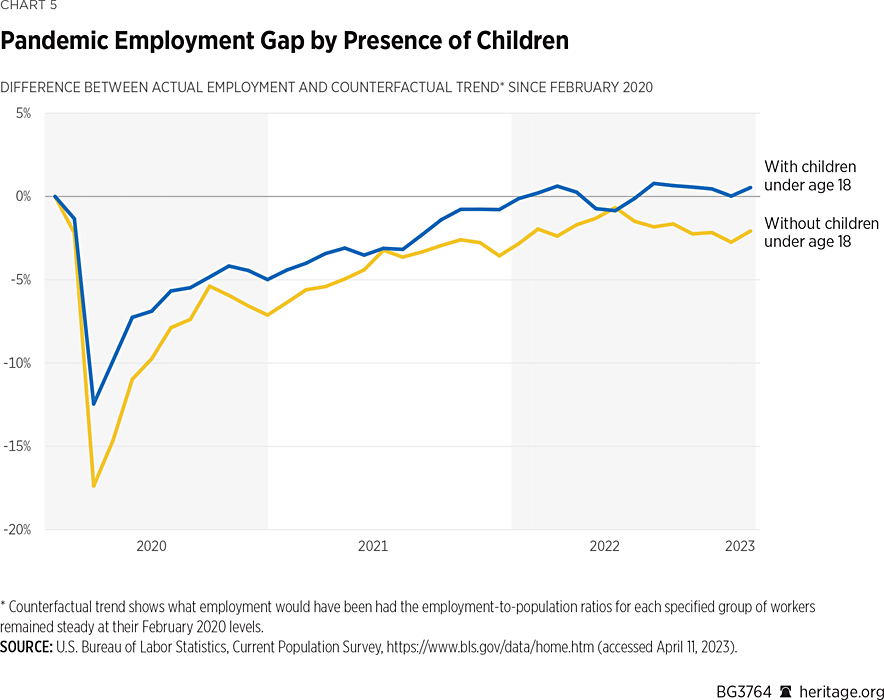
Throughout the pandemic, parents whose youngest child was under age six tended to experience smaller employment gaps than parents whose youngest child was between ages six and 17, or school-age. As of March 2023, employment of parents with children under age six had fully recovered and was 1.8 percent above February 2020 rates, while employment of parents with children ages six to 17 was 0.7 percent above February 2020 rates. An increase in homeschooling since the pandemic could be contributing to the relatively weaker, but still strong, recovery of parents with school-age children.
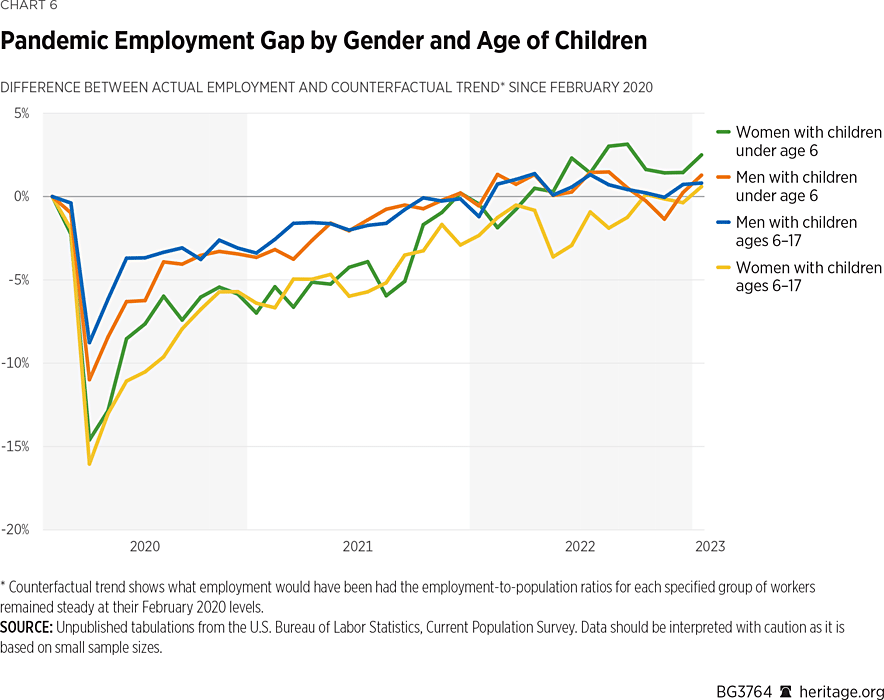
Of particular note is the fact that women with children under the age of six have a 2.5 percent employment surplus, which is nearly twice the next largest employment surplus of 1.3 percent for men with children under the age of six.
Multiple economic studies have shed light on the phenomenon of strong employment among parents of young children, essentially finding that childcare and family care struggles were real, but that they did not cause an excess decline in parents’ employment. REF While many women, in particular, were stressed by childcare and family care, they were stressed because they stayed employed as opposed to dropping out of the labor force.REF Intuitively, it may be that parents of young children held more tightly to employment out of awareness of the longer-term risks of unemployment and in recognition of their need to provide for their families.
Although it is still too soon to know long-term trends, it appears that a silver lining of the pandemic has been to prompt workplace and lifestyle shifts that have eased childcare struggles. For example, increased remote and flexible work arrangements have allowed some parents to do away with formal childcare, and job and location changes have allowed more families to make flexible and family-based childcare arrangements.
Potential Causes of Employment Declines
The COVID-19 pandemic affected nearly every facet of Americans’ lives. The direct health impacts, social isolation, school closures, and massive government spending that altered work incentives and stimulated a spike in home prices have all affected the labor market.
COVID-19 Health Impact. Prior to the development of the COVID-19 vaccines and treatments, health concerns about the coronavirus caused some people—particularly those with increased health risks—to withdraw from the workforce. In addition, some people have experienced long-term effects that have prevented them from working for weeks, months, or even years after recovering from a COVID-19 infection.
Studies that have looked at long COVID’s impact on employment have come up with wildly different estimates, ranging from keeping 500,000REF or fewerREF people out of the workforce to as many as 4 million people not working because of long COVID.REF
There are significant reasons to question high estimates of 1 million or more people not working because of long COVID. For starters, the Bureau of Labor Statistics (BLS) asked people who were not in the labor force if the reason they had not looked for work in the previous four weeks was the coronavirus pandemic. Answers in the affirmative included people who were concerned about catching the virus, anyone who was unable to work because of childcare or workplace closures, and many other COVID-19-related reasons, including experiencing long COVID symptoms that prevented them from working. Thus, these responses should be higher than the number of people prevented from working because of long COVID. In May 2020, 9.7 million who were not in the labor force said that they had not looked for work in the previous four weeks because of the pandemic. As of the last date that the BLS asked the question in September 2022, only 452,000 people said that they were not looking for work because of the pandemic. The fact that the BLS discontinued this series suggests that COVID-19 is no longer a significant factor in people’s decisions to look for work.
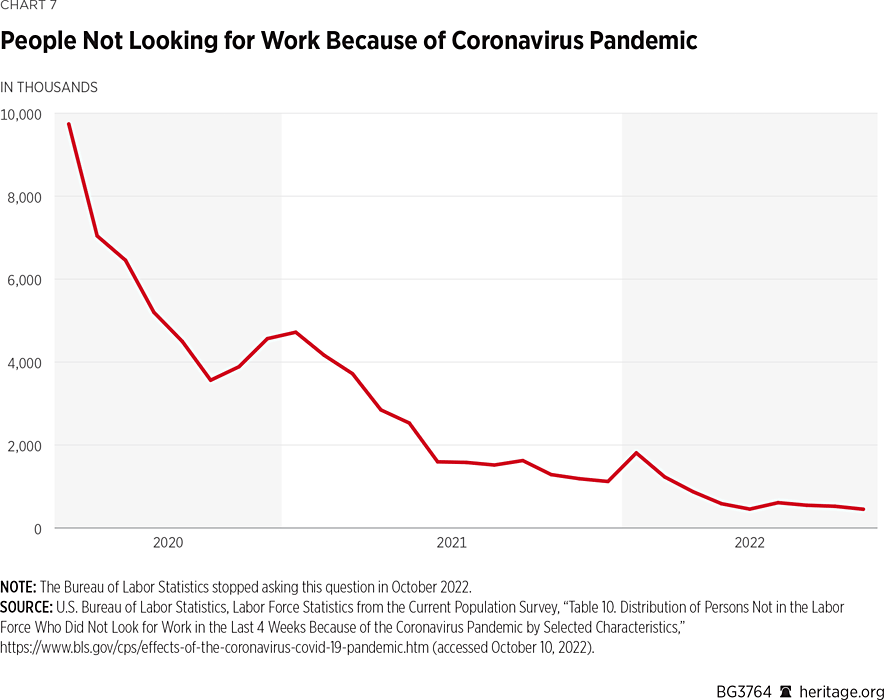
Moreover, early evidence suggests that COVID-19’s impacts on the workforce may be normal—perhaps even less impactful than non-COVID-19 illnesses that present similar symptoms. A study published by the Journal of the American Medical Association found that 39.6 percent of patients that tested positive for COVID-19 reported residual symptoms three months after their initial infection, while 53.5 percent of patients who experienced similar symptoms but tested negative for COVID-19 reported residual symptoms three months after their initial infection.REF
To the degree that long COVID is affecting individuals’ ability to work, the good news is that most people recover from significant long-COVID symptoms over time, and as a whole, the population of people experiencing long-COVID symptoms is declining. Survey data from the Census Bureau and the National Center for Health Statistics show that the percentage of people who have had COVID-19 and have experienced long COVID declined from 35.1 percent in June 2022 to 27.1 percent in March 2023. Moreover, the percentage of people who have had COVID-19 and were currently experiencing long COVID declined from 18.9 percent in June 2022 to 10.9 percent in March 2023.REF
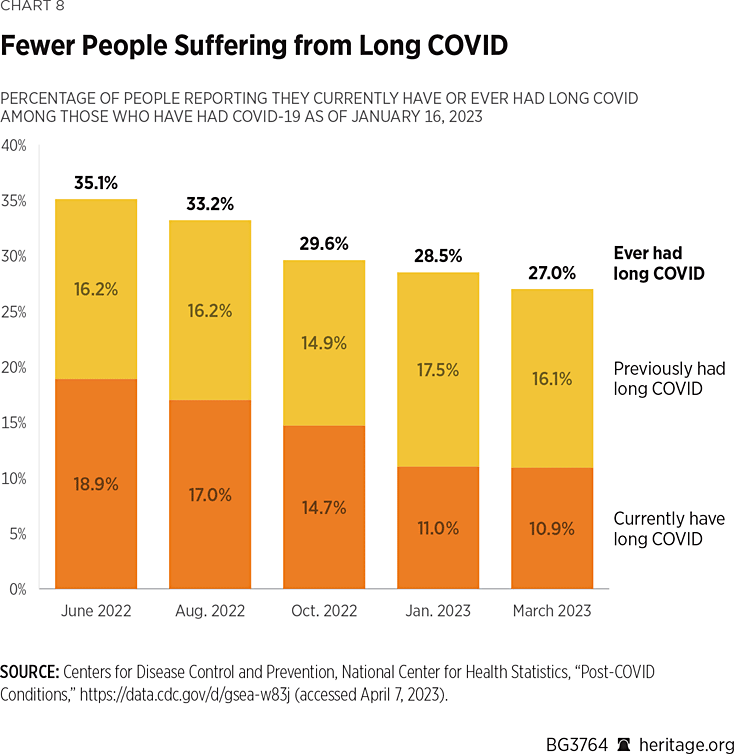
COVID-19 Pandemic + Opioid Epidemic. Well before the COVID-19 pandemic, increased opioid use was considered a significant factor in declining labor force participation, particularly among men. A study by the late Alan Krueger, economic advisor to President Barack Obama, found that increased opioid prescriptions could have been responsible for 20 percent of the decline in male labor force participation and 25 percent of the decline in female labor force participation between 2000 and 2015.REF Building on Krueger’s study, an analysis by Ben Gitis and Isabel Soto of the American Action forum estimated that 919,400 prime-age workers were absent from the labor force and total employment was 878,200 lower in 2015 (compared to 2000) as a result of opioid use.REF
Amid social isolation, anxiety, and limited access to physical and mental health care, substance abuse shot up during the COVID-19 pandemic.REF A study from the Federal Reserve Bank of Atlanta found that “increased substance abuse accounts for between 9 percent and 26 percent of the decline in prime-age labor force participation between February 2020 and June 2021.”REF Based on the 1.64 million-person decline in prime-age labor force participation over that period, this study suggests that the opioid epidemic accounted for the loss of between 148,000 and 426,000 prime-age workers from the labor force.REF Since the opioid epidemic affects workers across all ages, incomes, races, and geographic locations, it likely accounts for an even larger total decline in labor force participation. A December 2022 study by Isabella Hindley of the American Action Forum estimated that opioids were responsible for the loss of 1.3 million of a total of 6.3 million missing workers in 2021.REF
A Federal Reserve Bank study found that “increased substance abuse accounts for between 9 percent and 26 percent of the decline in prime-age labor force participation between February 2020 and June 2021.”
Rapid Home-Price Growth. Home prices shot up 26 percent in real, inflation-adjusted dollars between 2019 and 2021, marking the largest two-year real price increase on record.REF This increase in home values equated to a windfall increase in homeowners’ wealth. That increase in wealth was especially pronounced among older Americans as age and homeownership are highly correlated; 80 percent of Americans ages 65 and older own their homes compared to 66 percent of the population as a whole.REF By boosting homeowners’ nest eggs, a recent economic analysis by Jack Favilukis and Gen Li found that the increase in home prices caused a decline in older Americans’ labor force participation. After examining home prices and labor force participation by age across metropolitan areas, the authors concluded that “the Great Resignation among older workers can be fully explained by increases in housing wealth.”REF
Policies to Promote Employment, Educated Workers, Higher Incomes, and General Well-Being
Flawed policy responses to the COVID-19 pandemic caused a significant decline in employment and labor force participation and simultaneously created unprecedented demand for workers through massive government spending. This exacerbated a trend of declining labor force participation and employment that began two decades ago, at the turn of the 21st century.
Economic headwinds and the worsening U.S. fiscal outlook make the need for better education, labor, and tax policies especially urgent.REF The fact that employment gaps are concentrated in young workers, childless workers, and those over age 65 indicates that more education and income opportunities are the solutions. And the fact that parents’ employment has more than fully recovered indicates that a costly new federal childcare entitlement—particularly one that would drive up costs, limit supply, and disproportionately benefit high-income and already working families—would do little to increase employment and would add to inflation and federal budget woes.
When it comes to maximizing employment, policymakers need to abandon attempts to expand the government’s influence over people’s lives and instead expand individuals’ income opportunities by removing government-imposed barriers to work.
Federal and state policymakers should:
- Make welfare work-oriented. President Bill Clinton quoted Robert Kennedy when he said: “Work is the meaning of what this country is all about. We need it as individuals, we need to sense it in our fellow citizens and we need it as a society and as a people.”REF Work is crucial to breaking cycles of poverty and dependence, which is why the primary goal of welfare should be to help individuals and families to thrive by empowering them, through work, to earn a living that allows them to make their own decisions and pursue their own goals. Welfare benefits for work-capable individuals must be tied to work.
- Reduce government spending so inflation does not make workers poorer. The surge in federal government spending over the past two years is undoubtedly fueling inflation, which has resulted in the average worker losing $3,000 of purchasing power despite gaining $5,600 in additional wages.REF The greater the returns to work, the more work that people will do. Congress must immediately reduce spending, starting first with ending recent spending expansions and followed by enacting entitlement reforms so that workers’ incomes do not continue to erode through inflation and the higher taxes needed to finance massive debt.
- Expand apprenticeship programs by ending the government monopoly. Too few education options restrict opportunities for successful careers. A 2017 study by Harvard Business School and Burning Glass Technologies estimated that the number of occupations commonly filled through apprenticeships could nearly triple, that the number of job openings filled through apprenticeships could expand eightfold, and that the occupations ripe for apprenticeship expansion could offer 20 percent higher wages than traditional apprenticeship occupations.REF The Apprenticeship Freedom ActREF and Training America’s Workforce ActREF would enable apprenticeships to develop across more industries, resulting in more students being able to access on-the-job, paid education ending in a successful career.
- Reform accreditation to provide more post-secondary options. Current federal student loans and grants crowd out alternative, and often more effective, education options by limiting where students can use federal aid. The Higher Education Reform and Opportunity (HERO) Act would decouple federal student loans and grants from the federal accreditation process so that federal student aid could follow students to institutions and individual courses that are credentialed under a state’s accreditation system. This would allow students to have a more customized higher education experience, enter the labor market sooner, and reduce debt burdens.REF
- Replace failed federal job-training programs with more effective private, and state or local, programs. The federal government spends billions of dollars each year on job-training programs that fail to provide workers with education and experience that helps them to find and retain jobs. The Workforce Investment ActREF and Job CorpsREF programs, for example, have had few positive employment effects.REF Instead of wasting taxpayer dollars and workers’ time on failed federal job-training programs, policymakers should allow workers to benefit from more effective employer-provided programs.REF
- Phase out federal subsidies for higher education to unleash more effective, lower-cost alternatives. Employers report that college graduates increasingly lack the skills they need for the workplace. Federal subsidies for higher education inflate total costs, reduce the returns to higher education, and enable higher education institutions to fail to provide relevant education. The U.S. Department of Education should stop adding gasoline to the fire and allow private financial institutions to pick up any gap in new loans and financial aid.
- Prohibit blanket student-loan “forgiveness.” The nearly three-year pause on student loan repayments has reduced the incentive to work, and permanent forgiveness would encourage idleness and apathy in education and work pursuits. Congress should immediately prohibit the Biden Administration’s pending proposal for blanket student-loan forgiveness, which would be inflationary, morally hazardous, regressive, and tip the scales away from more effective education alternatives.REF
- Review and eliminate unnecessary occupational licensure laws. In theory, licensure laws safeguard the public from unqualified or unscrupulous practitioners; in practice, most state licensure schemes act as cartels that protect incumbents from competition.REF Licensure laws are especially harmful to younger and lower-income individuals and the more than one in four American adults that has a criminal record.REF Requiring people to pay hefty fees and attend dozens or hundreds of hours of training before they can legally become barbers, bartenders, ballroom dance instructors, florists, or hair braiders limits work and income opportunities and drives up costs for consumers. State policymakers should review existing licensure laws and maintain only those that are truly necessary to protect consumers.
- Protect independent work by codifying a bright-line test for employees vs. independent contractors. The more control that people have over their work, the more work they perform.REF Not everyone can work a traditional nine-to-five job, many people want to be their own bosses, and workplace flexibility is high on many people’s priority list. That is why one in three workers in the U.S. participates in independent work.REF Current ambiguity and conflicting definitions across federal law—including a pending regulation to drastically restrict independent contractingREF—impede work opportunities. As labor unions and liberal politicians seek to take California’s disastrous attempt to restrict independent work (through the AB5 law) nationwide, Congress should protect independent work by establishing a bright-line test for independent contractor status under the Fair Labor Standards Act, the National Labor Relations Act, and the tax code based primarily on how much control an employer exerts over a worker, and with deference to workers’ preferred classification in cases of ambiguity.
- Allow accessible, affordable, and portable worker benefits. The average worker will change jobs 12 times throughout his career, but no one wants to roll over their 401(k) plan or change health insurance 12 times. Current policies make it difficult for workers to obtain portable benefits. Congress and the Administration should look to remove barriers for workers to obtain traditional workplace benefits, such as retirement savings and health and disability insurance.
- Eliminate Social Security’s retirement earnings test. Social Security’s misunderstood earnings test is perceived by workers as a 50 percent tax on their earnings, which causes people to work less, and thus earn less, than they otherwise would. Policymakers should end this paternalistic and economically detrimental policy so that older Americans are not discouraged from working and earning more.
- Enact the Save Local Business Act to protect the franchising pathway to entrepreneurship. About 730,000 individually owned franchise operations employ 8.4 million workers across the U.S., but the Biden Administration’s National Labor Relations Board issued a proposed rule that will upend this successful small business model by redefining who is a “joint employer.” The Save Local Business ActREF would rightly codify the long-standing precedent that a person or entity is an employer of an employee only if that person or entity exercises direct and immediate control over the employee’s essential terms and conditions of employment.
- Prioritize workers’ choices about unionization. Congress should prioritize workers’ choices and respect unions’ resources by enacting the Workers Choice Act.REF This would eliminate forced unionization laws and “exclusive representation” laws so that workers do not have to pay for representation they do not want, and unions do not have to use their resources to represent workers who do not pay union dues.REF
- Enact the Employee Rights Act. This recently reintroduced package of labor law modernizations, which incorporates many of the above recommendations, would help to expand employment by protecting existing and expanding work models, while respecting the rights of people to work in the ways that they prefer.REF
- Repeal the Davis–Bacon Actand end project labor agreement (PLA) requirements in federal construction projects. The Davis–Bacon Act purports to require federal construction contracts to pay the “prevailing wage,” but the application of a flawed, non-scientific process typically results in inflated union wages that restrict employment being set as the prevailing wage.REF PLA requirements generally limit federal construction projects to unionized workers that represent only 14 percent of all construction workers.REF Congress should repeal these restrictions to allow more construction employment opportunities and to end the practice of penalizing workers and companies that choose to work directly with one another instead of through a union.
- Expand accessible, affordable childcare. Childcare is critical for parents of young children who want or need to work, but it needs to be the type of care that parents want. The federal Head Start program for children from lower-income homes has mediocre outcomes and limited hours of operation, which means that it is often not a viable childcare solution for working parents.REF Congress should allow parents to use federal childcare subsidies and Head Start funds at a provider of their choice.REF
- Remove barriers to work flexibility. Congress should enact the Working Families Flexibility ActREF so that lower-wage workers can choose to accrue paid time off in exchange for overtime work. Congress should also remove an unintentional barrier in the Fair Labor Standards Act that makes it harder for businesses to offer childcare benefits.REF
- Prevent tax increases. When employees and employers can keep more of what they earn, they will work more and put those higher incomes toward productive activities.REF
- Enable greater natural wage increases. Policymakers should eliminate double taxes on investments that boost productivity and wages.REF
- Make saving easier through universal savings accounts (USAs). Personal savings provide a cushion for unemployment, and they can help to boost people into better employment opportunities, including entrepreneurial ventures. Personal savings are also important for education, childcare, taking family or medical leave, and covering unexpected expenses. The inability to access savings without incurring penalties is a significant barrier to saving in tax-preferred accounts, but when people can save in one place for all their needs, they are far more likely to save.REF Congress should enact USAs so that workers can save in a single, simple account for all their needs.
Conclusion
At a societal level, an ample and engaged workforce is fundamental to economic growth and rising standards of living. Work creates the goods and services that people need to live and to thrive: the food and electricity they consume, the health care that improves and saves lives, the education that enriches knowledge and capabilities, and the research and innovation that have allowed people to do and experience things—literally at their fingertips through taps on a screen—that were unfathomable just a generation or two ago.
At a personal level, work is fundamental to human flourishing. In addition to supporting oneself and family, work provides an innate sense of dignity and purpose, and it is a means of expressing uniquely human creativity, perseverance, and accomplishment. Work is also fundamental to human identity and belonging; regardless of job titles or income levels, a shared work ethic and experience help to build communities and contentment.
The recent drop in work and labor force participation—particularly among young and childless workers—is troubling, especially as it exacerbates a two-decade-long decline. Today’s employment gap is 2.0 million workers, or 1.3 percent of the workforce. Job openings have edged down over the past few months, but remain extremely high at 9.9 million, and 43 percent of small businesses report job openings that they are unable to fill. Despite some high-profile layoffs, the overall layoff rate remains low and the quits rate remains high, indicating a still-strong labor market for workers. As evidence of that strength, as well as ongoing inflation eating away at workers’ wages, a net 42 percent of businesses said that they increased compensation in March 2023, and a net 22 percent said that they planned to increase it over the following three months.REF
Low levels of labor force participation are still hurting the American economy, including causing businesses to struggle to hire and retain the workers they need, thwarting the Federal Reserve’s efforts to fight inflation, and adding to extreme deficits. Continued low levels of employment overall will reduce the rate of economic growth, reduce real incomes and output, result in greater dependence on government social programs, require higher levels of taxation, and exacerbate the U.S.’s already precarious fiscal situation.
Improving labor force participation, along with the economy and the federal government’s fiscal outlook, requires creating an environment in which more Americans want to pursue work and are able to maximize their productive capabilities. Reducing education and skills gaps requires expanding effective and low-cost or no-cost education options by reducing federal interventions in the higher education market and expanding apprenticeship options. As federal attempts at job training and welfare-without-work programs have failed to benefit workers and have often hurt them, the federal government can do more for American workers and families by removing barriers to work that it has created than by creating new or expanded programs and regulations that reduce the returns to work.
Rachel Greszler is Senior Research Fellow for Economics, the Budget, and Entitlements in the Grover M. Hermann Center for the Federal Budget at The Heritage Foundation.



